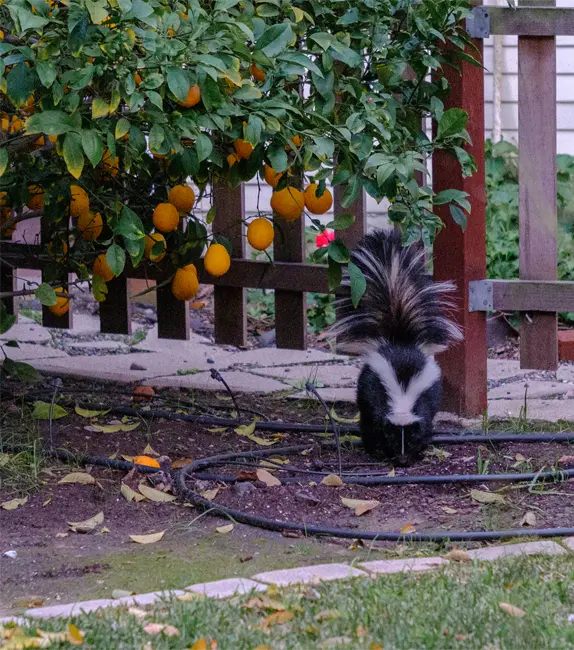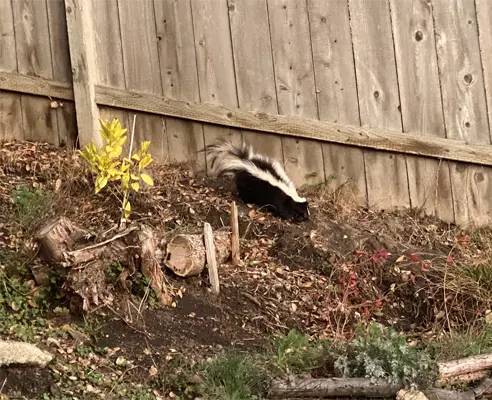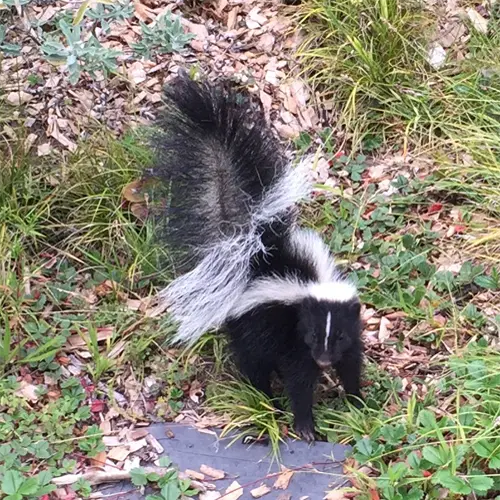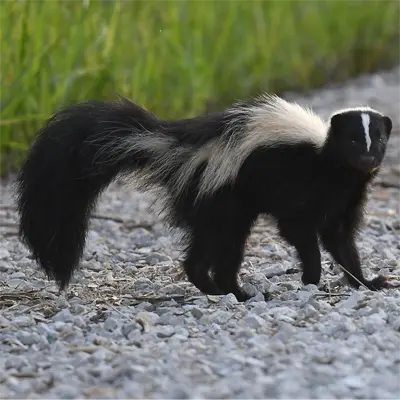Striped Skunks in Central Florida
The striped skunk (Mephitis mephitis) is a distinctive black and white furred mammal that inhabits regions of central Florida. Often considered pests, skunks are in fact an important part of local ecosystems. This guide covers skunk identification, biology, habitat, diet, health risks, and prevention and control in central Florida.
Appearance and Identification
Skunks have black fur with distinctive white stripes running down their back and sides. Their tails are long, bushy, and patterned with white. Skunks can be identified by
Skunks have a more streamlined body shape, with a bushy tail and white stripes on their back. Opossums have a more hunched over appearance, with a hairless tail and a pointed snout. Weasels are much smaller and have brown fur. Identifying tracks, dens, droppings and other signs also helps detect skunks.
Maturation Rate
Skunk kits grow rapidly after birth. Their eyes open after 3-4 weeks, they are weaned by 8 weeks, and reach adult size by 4 months old. Sexual maturity occurs by the following breeding season at just under one year old for both males and females.
Habits and Behavior
Skunks are omnivorous and prey on a variety of small animals, insects, grubs, and plants. They are primarily nocturnal and solitary creatures. During the day, skunks retreat to dens dug under sheds, porches or wood piles. Attics, hollow logs and abandoned burrows are also used for shelter.
Skunks have poor eyesight but excellent senses of hearing and smell. They shuffle slowly with a plodding gait and arch their tail high over the back when threatened. Skunks provide natural pest control by feeding on rodents and insects, but also damage lawns and gardens when foraging.
Reproduction and Lifespan
Breeding season for striped skunks in central Florida is typically February through March. After a 2 month gestation period, females give birth to 2 to 10 young. Babies are born blind, deaf and covered in fine hair in an underground den lined with dried grasses.
Young skunks open their eyes after 3 to 4 weeks and are weaned around 2 months old. They follow their mother single file and learn to hunt insects and small prey. Juveniles become independent by the fall but may den together over winter.
Skunks live up to 3 years in the wild. Main causes of mortality include motor vehicle collisions, disease, predators and starvation over harsh winters.
Ideal Habitat and Range
The warm, humid climate of central Florida provides ideal habitat for skunks to flourish. Average temperatures range from the mid-60sF (18C) in January to the low 90sF (32C) in July. Annual rainfall totals 50+ inches across the region.
Abundant water, mixed forests, wetlands and agriculture provide ample food year-round. Skunks den in hollow logs, abandoned burrows, under porches and sheds. They are highly adaptable to urban areas and find shelter and insects in suburban yards. Garbage, pet food, and rodents also sustain skunk populations.
As omnivores and productive breeders, skunks thrive across central Florida’s varied terrain. Their defense spray and lack of real predators allow them to inhabit parks, farms, residential areas and wildlands in great numbers. Care must be taken to avoid encounters by sealing dens and removing attractants.
Diet and Feeding
Skunks are omnivorous and eat both plant and animal matter. About 70% of their diet consists of insects, larvae and worms. The rest is small vertebrates, fruits, berries, nuts, eggs and garbage. Skunks use their long claws and snout to dig and root around for food.
Typical foods include:
- Insects – beetles, crickets, caterpillars, grubs, spiders
- Small mammals – mice, voles, shrews
- Reptiles and amphibians – lizards, frogs, snakes
- Bird eggs and nestlings
- Berries – blackberries, raspberries, mulberries
- Fruits – figs, persimmons, grapes, avocados
- Fungi – mushrooms, truffles
- Nuts – acorns, pecans
- Corn, oats, wheat
- Garbage, pet food
Skunks hunt and forage mostly at night. They shuffle slowly with nose to the ground seeking scent trails. Skunks will travel 1/2 to 1 mile nightly in search of food.


Common Health Risks
While beneficial natural pest controllers, skunks can also pose health and nuisance risks including:
- Rabies – Skunks are a primary rabies carrier. The fatal virus is spread via saliva from bites.
- Roundworms – Skunk feces spreads roundworm eggs which can cause larva migrans.
- Leptospirosis – Skunk urine contains bacteria that can cause serious illness in pets and humans.
- Allergies – Skunk spray, scent marking, dander and feces aggravate allergies.
- Property damage – Skunks dig up lawns, gardens, and damage structures when denning.
- Odors – Powerful musk spray causes lingering, unpleasant skunk odors outdoors and indoors.
Preventing Skunks
Follow these tips to deter skunks from your property:
- Seal all foundation openings and holes with wire mesh, rocks, or concrete.
- Install grates over window wells and storm drains.
- Use wildlife-proof garbage cans and restrict pet food at night.
- Clean up fruit windfalls and spilled seed from bird feeders.
- Use motion-activated lighting and sprinklers to startle skunks.
- Remove wood and rock piles that can serve as dens.
Trapping and removal of skunks should only be done by licensed wildlife experts given the risk of spray and disease. Prevention through exclusion and removing attractants is most effective.

Population Control Methods
If exclusion alone is insufficient to prevent Florida water rat damage, lethal control using traps or rodenticides may be considered. Traps such as snap traps, cage traps, or body-grip traps can humanely capture rats for relocation or euthanasia. Glue boards are another trapping option.
Poison baits are also effective but must be used cautiously around waterways. Zinc phosphide baits are commonly used though anticoagulant baits are safer for wildlife. Control is most effective when animals are active in spring through fall – winter trapping is less productive.
Always follow label directions carefully when utilizing any rodenticides.
Florida Water Rats in Central Florida – Conclusion
The striped skunk is well-adapted to the warm, humid climate of central Florida. Abundant shelter and food allow skunks to thrive from wildlands to suburbs.
While beneficial insect controllers, skunks can also spread rabies and cause property damage when uncontrolled. Sealing entry points to homes, removing attractants, and deterrents can help prevent conflicts with skunks in central Florida.







